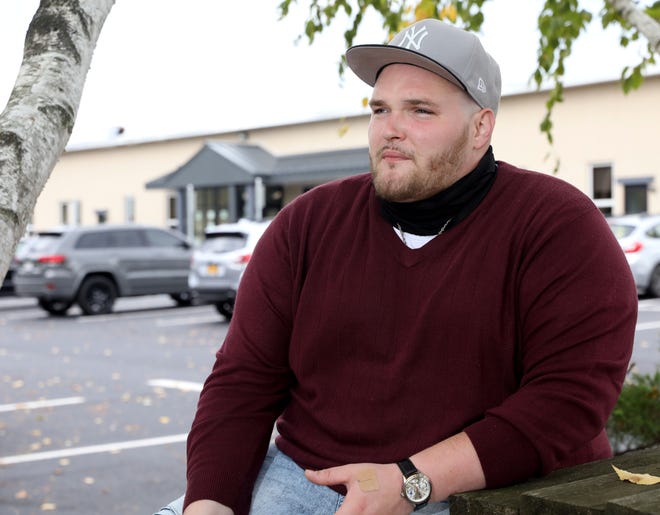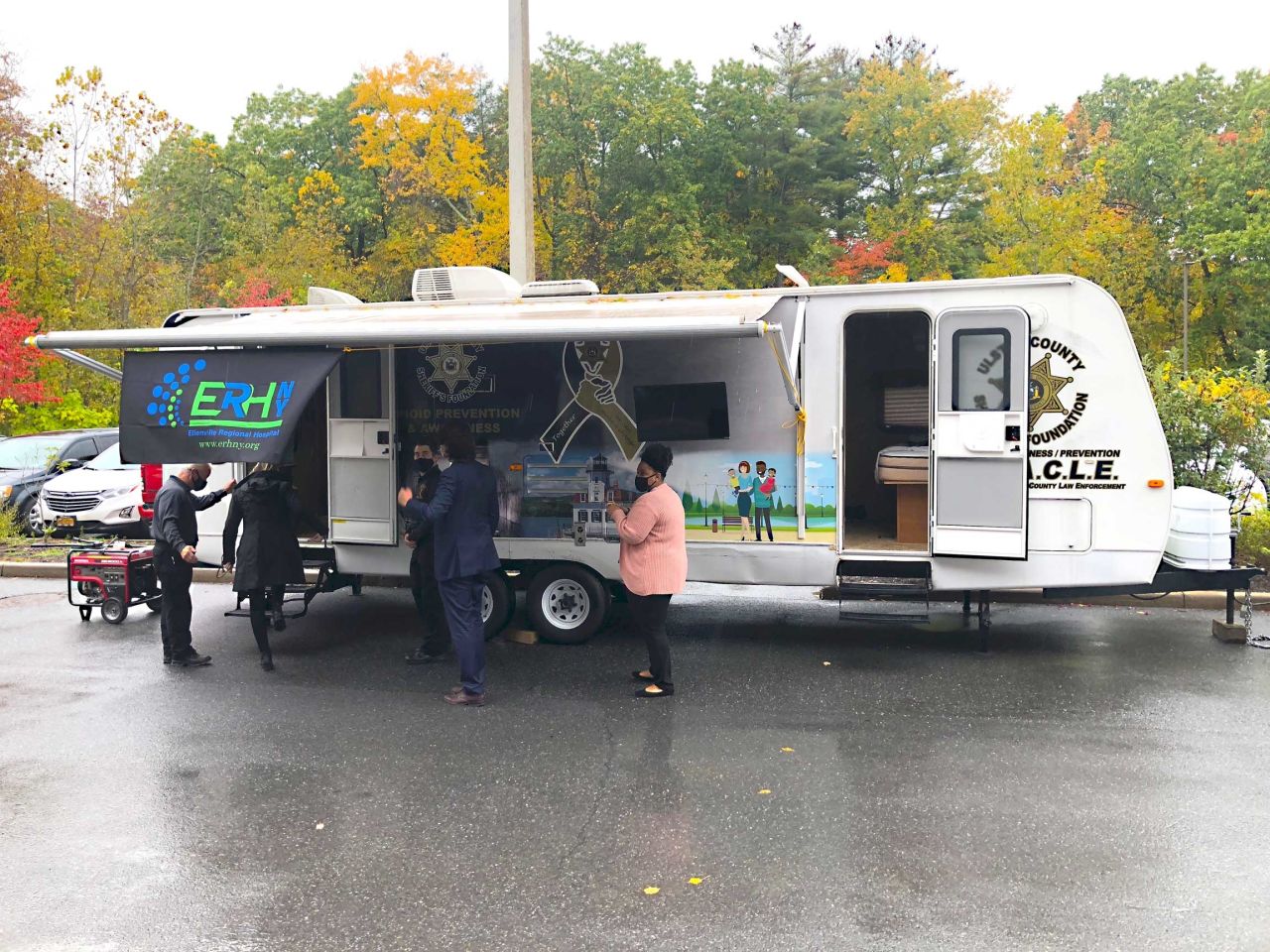Advancing Public Policies for people with Mental Illness, Substance Use Disorder and/or Intellectual/Developmental Disabilities
|
|
 |
|
|
Three Western New York Cities At High Risk for Mental Health Crisis Due to Pandemic
Six months into the COVID-19 pandemic, the mental health impacts of the stay-at-home orders, financial stress, and uncertainty continue to weigh on Americans. 53 percent of U.S. adults report that the virus negatively impacted their mental health, according to a July Kaiser Family Foundation poll.
But some cities are more at risk for the negative effects of the virus and poor mental health including three in Western New York.
Buffalo, Rochester and Syracuse were identified as three of 13 cities where COVID-19 vulnerability and poor mental health overlap, according to an October 2020 analysis done by the Surgo Foundation and Mental Health America (MHA). Read more here. |
|
 |
|
|
Overdose Deaths on the Rise in Dutchess. Here's Why and How the County is Combatting It

Brandon Hildwein was six months into his recovery when COVID-19 became a pandemic.
The treatment he was receiving through the Lexington Center for Recover methadone program was working. He no longer felt the need to carry heroin in his pocket. For around a month, that had been his backup plan, in case he started to feel his life spiral out of control.
That's exactly what happened for many when the isolating effect of the pandemic began to set in.
Being clean, Hildwein, who is living in Poughkeepsie, knew he could reach out to his counselor or family in those moments of isolation in which he did question his recovery.
"I learned how to cope with stuff (before the pandemic started), like being able to talk about my triggers, and not just try to isolate and deal on my own," the 30-year-old said.
In the last four months, however, Hildwein has lost two childhood friends to overdoses. Both, he said, had been cut off from the support of their families, leaving them alone with the urges and voices that can be heard in quiet moments of loneliness. The number of overdose deaths in Dutchess County increased by more than 50% in the first half of this year, a resurgence of a crisis that statistically improved through 2019. Jean-Marie Niebuhr, the head of Dutchess County's Opioid Task Force, said both the pandemic and bail reform each played a role, but she is is reluctant to blame any one factor for the spike because there isn't data to support such a claim. Read more here.
|
|
 |
|
NIH Outlines Plans for HEALing Communities Study
In a piece penned for the journal Drug and Alcohol Dependence, officials from the National Institutes of Health have outlined additional details on plans for the HEALing Communities Study, a large-scale initiative that will attempt to address gaps in efforts to reach the communities that have been hardest hit by the opioid epidemic and provide evidence-based interventions for OUD. The study, funded by the NIH Helping to End Addiction Long-term (HEAL) Initiative, will be co-administered by NIH and the Substance Abuse and Mental Health Services Administration. The HEALing Communities Study was first announced in May 2019 as a $350 million, multi-year project with the goal of reducing opioid-related overdose deaths by 40% over three years. Read more here.
|
|
 |
|
|
 |
|
UPCOMING EVENTS & TRAININGS
Suicide Assessment and Response for K-12 Populations
October 27, 4 - 5 pm, SAMHSA
Introduction to PSYCKES
October 28, 1 - 2 pm, OMH
Virtual Discussion: Let's talk about CHART - Community Health Access and Rural Transformation Model
October 28, 4 - 5 pm, Rural Health Value Team
Understanding Trauma-Informed Care and Cultural Humility and the impact on Supporting Individuals with Intellectual and Developmental Disabilities
October 29, 1 - 2 pm, National Council for Behavioral Health
Diverting People with Intellectual and Developmental Disabilities from the Criminal Justice System
October 29, 2 - 3:30 pm, The Council of State Governments (CSG) Justice Center and the Bureau of Justice Assistance (BJA)
Helping Those Who Help Others Panel Discussion
October 30, 1 - 3 pm, OMH Suicide Prevention Office
Technology Update: Impacts On Treatment
November 4, 12 - 1 pm, PsychU
Navigating PSYCKES Recipient Search for Population Health
November 5, 10 - 11 am, OMH
Understanding Social Determinants of Health
November 5, 2 - 3 pm, Corporation for Supportive Housing
Using PSYCKES from Home
November 10, 11 am - 12 pm, OMH
Where to Start: Getting Access to PSYCKES
November 17, 10 - 11 am, OMH
PSYCKES Mobile App for iPhones & iPads
November 18, 1 - 2 pm, OMH |
|
 |
|

|
OCTOBER 2020
Mental Health Committee - 730 Work Group
October 27: 11 am - 12 pm, GTM
Developmental Disabilities Committee Meeting
October 29: 1 - 2:30 pm, GTM
NOVEMBER 2020
CLMHD Office Closed - Veterans Day
November 11
Addiction Services & Recovery Committee Meeting
November 12: 11 am - 12 pm, GTM
Children & Families Committee Meeting
November 17: 11:30 am - 1 pm, GTM
CLMHD & State Agency Day
November 18, GTM
OASAS: 9:30 - 11:30 am
OMH: 12:15 - 2 pm
OPWDD: 2:30 - 4 pm
Mental Health Committee - 730 Work Group
November 24: 11 am - 12 pm, GTM
Mental Hygiene Planning Committee
November 24: 1 - 3 pm, GTM
CLMHD Office Closed - Thanksgiving
November 26 - 27
Contact CLMHD for all Call In and GoToMeeting (GTM) information, 518.462.9422
|
|
|
Using Local Data to Reduce Suicide Death
Barbara Bernstein, PhD, MPH, MHA of Westchester & Michael Orth, MSW, Westchester County Department of Community Mental Health
Suicide is often considered to be the most preventable cause of death. Yet, recent years have seen steadily rising numbers of loss to suicide in the United States. This rise has occurred despite the cultural shift that has allowed the fact of suicide to come "out of the closet;" despite the cultural shift that recognizes that thoughts of suicide are not rare; despite the cultural shift that encourages individuals to talk about these thoughts; despite the cultural shift that encourages individuals to seek the support and assistance that is best for their individual needs and preferences; and despite the cultural shift that recognizes that hospitalization is not necessarily the most helpful intervention. The concept of "deaths of despair" - deaths ultimately due to suicide, drug overdose and alcoholism - but driven by social and economic forces that render life so challenging for so many - has become part of our lexicon. We understand so much about risk factors at the individual and societal level. Our clinical and peer support skills have improved. We are more skilled at identifying and intervening with emerging crises. So why do we continue to lose loved ones at an increasing rate, and most importantly, what can we do to reverse this painful reality? To address this community problem, Westchester County recently launched a Suicide Fatality Review Team (SFRT). The SFRT is a public health approach that analyzes local data to identify risks specific to Westchester County in order to develop specific county-level prevention and intervention approaches. Westchester is one of four sites selected by the New York State Office of Mental Health to adapt this effective model which was developed in Washington County, Oregon. Read more here.
|
|
 |
|
|
Purdue Pharma Pleads Guilty to Criminal Charges for Opioid Sales
Purdue Pharma, the maker of OxyContin, has agreed to plead guilty to criminal charges related to its marketing of the addictive painkiller, and faces penalties of roughly $8.3 billion, the Justice Department announced on Wednesday. The settlement could pave the way for a resolution of thousands of lawsuits brought against the company for its role in a public health crisis that has killed more than 450,000 Americans since 1999.
The company's owners, members of the wealthy Sackler family, have agreed to pay $225 million in civil penalties. Prosecutors said the agreement did not preclude the filing of criminal charges against Purdue executives or individual Sacklers.
The federal settlement does not end all of the extensive litigation against Purdue, but it does represent a significant advance in the long legal march by states, tribes, cities and counties to hold the most prominent opioid maker accountable. Read more here.
|
|
 |
|
|
Department of Justice Announces More Than $341 Million in Grants to Combat America's Addiction Crisis
The Department of Justice last week announced grant awards totaling more than $341 million to help fight America's addiction crisis. Office of Justice Programs (OJP) Principal Deputy Assistant Attorney General Katharine T. Sullivan discussed this year's grant awards during a roundtable discussion of mental health and addiction issues led by Second Lady Karen Pence.
Illegal drugs and illicit drug use have claimed the lives of nearly 400,000 Americans since the turn of the century. Powerful synthetic opioids like fentanyl are exacting an enormous toll on families and communities, and an emergence in the use of methamphetamines and other psychostimulants is drawing drug traffickers and driving up overdose rates. Three years ago, President Trump declared a Public Health Emergency and initiated a whole-of-government approach dedicated to ending this national tragedy. The Department of Justice has invested unprecedented levels of funding in combating the addiction crisis. The awards announced today build on those earlier investments. Read more here. Additional articles of interest:
|
|
 |
|
|
Essex County Works to Reach Troubled Children Earlier
Using a set of data points, social workers can usually tell which 6-year-olds will be in trouble by age 12. But if the help doesn't arrive until trouble begins, it's often too late and the child's chances of leading a happy productive life are greatly diminished.
So Essex County wants the help to arrive at a younger age, before behavioral and mental problems have taken root. "Before, we couldn't give them any services until the wheels had fallen off the bus," said Terri Morse, director of the Essex County mental health agency, who teamed up with Linda Beers at the county health department and Sue Ann Caron at social services, along with more than 40 other service and educational providers interested in charting a new course.
"This coalition came out of the fact that mental health and child-serving systems have historically been reactive in their response," Morse said. "We came together and said, we can do better, so we created a proactive system that addresses family needs earlier." Read more here. |
|
 |
|
|
Ulster County's New Approach to Battle Heroin, Opioids, Fentanyl

The fentanyl crisis, producing a dramatic surge in overdose deaths, has spurred creative thinking in police and government circles in Ulster, Green and Columbia counties. On Friday at a joint press conference, Congressman Antonio Delgado (D-19) joined State Senator Jen Metzger (D42), Ulster County Executive Pat Ryan, Ulster County Sheriff Juan Figueroa, and Steve Kelley, CEO of Ellenville Regional Hospital, which has taken a leading role in fighting the opioid and fentanyl menace.
In his remarks Congressman Delgado said, "Some of the most heartbreaking encounters that I have are with parents who've lost a child, or a brother or sister who is reflecting upon having lost a brother or vice versa. Tears typically accompany these conversations. I think about those families every day when we're talking about these issues."
He noted that Sullivan County now has the highest overdose rate per 100,000 people in New York State. Meanwhile, Ulster County has seen opioid-related deaths increase by 345 percent since 2010.
Kelley said that the crisis on this front has intensified again. "We know that... we're having another wave. And so it is very likely that we will eclipse our worst year [2017] this year, during the COVID epidemic."
Sheriff Juan Figueroa discussed the ORACLE team, one of the partners in a new approach to the long-running crisis of opioids and heroin, and now fentanyl. Read more here.
Additional article of interest: Rep. Delgado Joins Ulster Community Leaders to Launch High Risk Mitigation Team Initiative to Address Opioid Addiction
|
|
 |
|
|
In Dire Condition, Nonprofit Human Services Sector Launches Recovery Effort
Nonprofits that provide human services have played an additionally vital role during the coronavirus pandemic in feeding, sheltering, and caring for New Yorkers. But the sector, which was already facing dire financial straits in recent years, has been devastated as fundraising has ground to a halt, city funding has been cut, and state contract payments have been put on hold. The Human Services Council, an organization that represents more than 170 providers in the state, is convening a new task force on Tuesday as it hopes to examine the consequences of the pandemic and how the human service sector can rebuild as the economy recovers.
As the pandemic led to billions in lost tax revenue for the city and state, budget officials began to cut spending but the need for services provided by contracted nonprofits only increased. Organizations that sheltered homeless people or delivered meals to the elderly, for instance, adapted to the pandemic even as they too began to lose revenue and struggled to pay their bills. The Human Services Council estimates that as many as 1,800 nonprofits across the state could close down in the wake of this crisis, leading to almost 14,000 layoffs. Many have already shuttered their doors. Read more here.
|
|
 |
|
Outlining Social Services Options Key to SDOH Screening 
Patients who hear about different options for social services referrals before social determinants of health (SDOH) screening are more likely to be accepting of that assistance than those who don't, according to a study published in JAMA Network Open. This finding, among others regarding patient receptiveness to social services referrals, may influence how providers conducting SDOH screening moving forward. As a part of healthcare's overall transition to value-based care, an increasing number of providers have recognized the importance of screening for and intervening in the social determinants of health. Designing community-based programming and partnering with social services providers has helped healthcare organizations address the social factors that also impact a patient's ability to achieve health and wellness. But screening for SDOH is not always cut-and-dry. Asking a patient about the social factors that are challenging for her or her family can make the patient feel vulnerable, and some evidence has suggested patients feel closed off during those discussions. Read more here.
|
|
 |
|
New York's Strict Requirements for Insurers' Mental Health and Substance Use Disorder Parity Compliance and Oversight Programs May Serve as a Blueprint for Other States
The Mental Health Parity and Addiction Equity Act ("MHPAEA") and related state parity laws are some of the most complex and sweeping regulations ever imposed on the health insurance and managed care industry. Although MHPAEA was enacted in 2008 and many states have mental health and substance use disorder ("MH/SUD") parity laws that are at least that old, federal and state enforcement efforts have ramped up significantly in recent years, especially through the implementation of increasingly granular documentation and reporting requirements.
To date, most regulators have focused oversight efforts on documentation of compliance with non-quantitative treatment limits ("NQTLs") related to utilization management, provider network management, and pharmacy benefits. On September 15, 2020, the New York State Department of Financial Services ("NYSDFS") finalized new regulations that build on these substantive compliance reports by setting forth a detailed set of specifications for the design and operation of the insurer's compliance and oversight program itself. The regulations, which take effect on December 29, 2020, expand on recent draft guidance from the U.S. Department of Labor ("DOL") to employer-sponsored health plans on the importance of building formal compliance programs. However, the New York regulations are far more detailed and prescriptive than the DOL or any other state guidance to date and apply to all insurers and health maintenance organizations offering coverage of MH/SUD requirements under New York's insurance laws. Read more here.
|
|
|